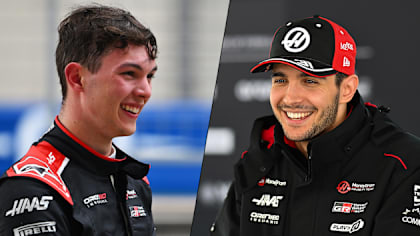
Feature
The beginner’s guide to F1 tyres
Share

Tyres are the only parts of a Formula 1 car that actually touch the racetrack and, as such, serve as a crucial reference point for drivers. Our beginner’s guide provides all you need to know about these highly advanced black circles of rubber…
Who supplies F1 teams with tyres to go racing?
Italian manufacturer Pirelli have supplied F1 teams with tyres since 2011, making a return to the sport after previous spells of involvement in the 1950s, ‘80s and ‘90s.
READ MORE: Pirelli to continue as Formula 1’s exclusive tyre supplier until 2027
Indeed, Pirelli were one of several companies to provide tyres at the start of the World Championship back in 1950, with a host of brands making appearances over the decades, during which time tyre technology has advanced as quickly as the cars.
Unlike some previous eras, where multiple tyre manufacturers competed against each other and created what was known as a ‘tyre war’, Pirelli are now F1’s sole, exclusive supplier, with an agreement running through the end of the 2027 campaign.

Pirelli’s F1 involvement stretches back to the 1950s, and the birth of the World Championship
What tyres are used in F1?
All-new 18-inch tyres were produced for the 2022 season as part of sweeping changes to the technical regulations, with every element made from scratch – spanning the profile, structure and various compounds.
Pirelli factored in more than 10,000 hours of indoor testing, 5,000 hours of simulation and 70 virtually developed prototypes to create 30 different specifications, which were then tested by teams across more than 20,000 kilometres. Further successful tweaks were made through 2023 and 2024.
Meanwhile, the company continued to focus on research and development of sustainable tyre solutions in their support of the sustainability targets set by F1 – with the sport aiming to be Net Zero Carbon by 2030. Pirelli became the first company to produce a complete range of Forest Stewardship Council–certified tyres for motorsport, with Formula 1 becoming the first motorsport competition to use them.
Beyond their impact in F1, Pirelli’s 18-inch tyres are also more in line with the products used by motorists every day – meaning transfer of technology becomes easier and the road industry benefits from the sport’s year-on-year innovation.

Pirelli have committed to F1 through 2027, with an option to extend for a further year
What about the tyre compounds used at each track?
Pirelli’s range of 18-inch tyres for the 2025 campaign comprises six 'slick' compounds (from hardest to softest: the C1, C2, C3, C4, C5 and C6), along with 'intermediates' and 'full wets' to account for inclement weather conditions.
The C6 is a new ultra-soft compound, which is expected to be used at certain street circuits, with drivers sampling it during a special practice session at last year’s Mexico City Grand Prix and the Abu Dhabi post-season test.
READ MORE: 5 things to be excited about as F1 gears up for the 2025 season
From the C1-C6 slick range, Pirelli pick three compounds to be used at each Grand Prix, taking into account track characteristics and climates – the hardest trio chosen for venues where the tyres are generally subjected to greater demands, and vice versa.
The highest-numbered slick tyre is marked red for the weekend and known as the 'soft' tyre, the middle choice is marked yellow and known as the 'medium', while the lowest-numbered is marked white and known as the 'hard' tyre, – all sitting alongside the green intermediate and blue full wet tyres.

Pirelli’s tyres are colour-coded to make it easier for fans to spot what compound each driver is using at any given time
In theory, the soft compound will offer the most amount of grip but only for a short period of time before they degrade, making them ideal for qualifying runs, while the hard compound is the opposite – lasting much longer but offering less grip (and slower lap times as a result). The medium and hard compounds are likely to be more favourable options over a race distance.
How many tyres do drivers get each weekend?
On a standard Grand Prix weekend, drivers are given 13 sets of dry weather tyres, four sets of intermediates and three sets of full wets. An extra set of softs is reserved for those who reach Q3 in Qualifying, while all drivers must use at least two different slick compounds during the race, providing the track is dry.
READ MORE: The beginner’s guide to the F1 Sprint
At Sprint events, the allocation of tyres drops from 13 sets to 12, with drivers getting two sets of the designated hards, four of the mediums and six of the softs. The total number of wet-weather sets remains the same (seven), but becomes five intermediate and two wet sets.
For more information about Pirelli’s F1 tyres, visit pirelli.com.

RACE TICKETS - JAPAN
Don't miss your chance to experience Formula 1 at the epic figure-of-eight Suzuka Circuit...
DISCOVER MORE...
Horner addresses speculation that Lawson could be replaced at Red Bull for Japanese GP
Leclerc and Gasly disqualified from Chinese Grand Prix over car weight breaches
HIGHLIGHTS: Watch the action as Piastri takes Chinese Grand Prix victory in McLaren 1-2
OBITUARY: Remembering Eddie Jordan, one of F1's most colourful characters
YOU MIGHT ALSO LIKE
News Ocon and Bearman hail ‘amazing’ Haas turnaround after double-points haul in China

Video HIGHLIGHTS: Watch the action as Piastri takes Chinese Grand Prix victory in McLaren 1-2
News Antonelli explains struggles in China after sustaining floor damage as he highlights main area to improve
News ‘It’s like my worst nightmare’ – Norris admits fright over late brake issue in China with Russell closing



